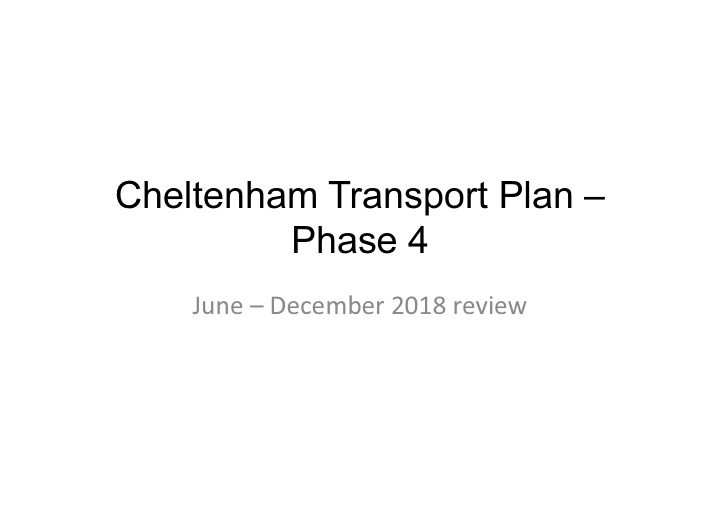



Cheltenham Transport Plan – Phase 4 June – December 2018 review
Overview • Implementation of CTP in phased approach approved in 2015. • Analysis of traffic flows undertaken after completion of each Phase • Report produced and discussed with Lead Cabinet Member.
Feedback to date Total of 798 submissions to GCC website: 376 formal representations; 422 general enquiries (comments / questions). GCC respond to ‘what’ enquiries, CBC respond to ‘why’ enquiries. General themes across all correspondence: – Access for businesses on Clarence Parade and the western end of Clarence Street; – Blue Badge Holder access to Pittville Street; – Concerns / comments on traffic increases on other routes around the town and increases in journey time. Streets mentioned include St. George’s Street and Rodney Road; and – Signage comments were primarily recorded in the initial month, but these have decreased following the additional traffic management introduced in early August;
Traffic Flow Monitoring Overview • 26+ Sites across the town. Mixture of fixed counters & temporary RADAR counters. • Sites on main roads and minor roads which may experience changes in flow / had been flagged by public. • Baseline data collected during November 2015 • Average 24 hour two-way flow used as baseline position as scheme is in place 24/7
Monitoring Site Map A4019 All Saints Rd Waitrose Trial Restriction Extents Albion St Rodney Rd Bath Rd Imperial Sq College Rd A40
Phase 4 Monitoring • Three data sets collected to date: – July 2018 (Primarily monitoring for any immediate issues) – September 2018 (first neutral collection period after start) – November 2018 (To provide comparison to baseline data)
Temporary Site Data 2015 -2018 Average 24 hour two-way flow at each site 12000 10000 8000 Nov 15 (Baseline) 6000 Sept 16 (Post-Phase 1) May 17 (Post-Phase 2) Feb 18 (Post-Phase 3) 4000 Sep-18 Nov-18 2000 0
Fixed Site Data 2015 -2018 Average 24 hour two-way flows at each site 18000 16000 14000 12000 10000 Nov 15 (Baseline) Sept 16 (Post-Phase 1) 8000 May 17 (Post-Phase 2) 6000 Feb 18 (Post-Phase 3) Sep-18 4000 Nov-18 2000 0
Phase 4 Monitoring Key Areas • Northbound routes (St. James Sq, Ambrose St, St. George’s St) • East (Rodney Road, High Street, Winchcombe Street S) • Data collaborates feedback from public • Growth between 20% and 35% but from a relatively small baseline • Mitigation measures being considered
Proposed Revisions to the Trial Address key themes raised in feedback: 1. Revised restriction. Maintains overall scheme objectives, and removes Clarence Parade / Clarence Street from the restrictions. 2. Additional blue badge bays in Winchcombe Street. Additional bays locations identified immediately north of High Street
Additional Works • Investigation into options for traffic calming on Rodney Road; and • Investigation into wider directional signing; and • Separate longer term improvement project for A4019 corridor (2020+)
Timeline/Next Steps • Mitigation measures likely to be install in April/May 2019 • 6 month consultation period following changes • TRO Committee to review experimental TRO - November or December 2019.
Headline impacts of Cheltenham Transport Plan First phase – Albion Street • Main beneficiary is service B Charlton Kings – Swindon Village with 7,000 users per week • Shorter route via Albion Street saves 1,500 miles p.a / 190 gallons of diesel • Route time saving c2 minutes from Charlton Kings; greater saving at peak times
Headline impacts of Cheltenham Transport Plan Current phase – Boots Corner • Since trial began in June 2018 passenger journey numbers in Cheltenham up 5,000 per week • This is 4% growth against a national picture of 2% decline and supports GCC Local Transport Plan target to maintain bus usage • Cheltenham bus punctuality up to 93.1% from 91.5% over 50,000 miles in Cheltenham per week • November 2018 weekend races meeting; buses taking 15% less time (8 mins) to travel from the Racecourse to the town, station and back to the Racecourse to undertake their next journey
Significant Positive Impacts • 85% drop in traffic at Boots Corner, - reduction of 800 vehicle per hour • 700 additional pedestrian movements per hour • 4% more bus passengers – 5,000 passenger journeys per week • Bus punctuality improvements • Number of cyclists tripled • 70% increase in wheelchair movements • 531 direct jobs generated
Recommend
More recommend